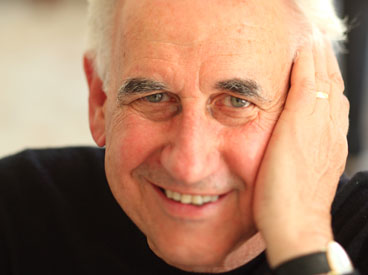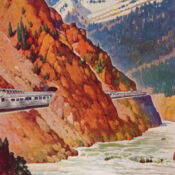I’d always dreamt of becoming a writer. When I was eight, I wrote what I called a novel about a star college football player who was mysteriously strangled with a stethoscope the night before the big game. That manuscript never made it into print, but when I was in the ninth grade, I published a story about my school football team’s victory in the regional championships that gave me my first taste of the power of the printed word.
I’d originally written the story for the school paper, but when I handed it in, the faculty advisor, the terrifying Mrs. Driscoll, objected to my description of the school’s poorly maintained field as “tattered” and told me she wasn’t going to publish the story unless I changed it. In a rare act of defiance, I refused to let her tamper with my precious words and published the story myself using my mother’s mimeograph machine. It was a huge hit. We sold hundreds of copies at five cents each, probably more because of my classmates’ burning desire to see what Mrs. Driscoll had censored than the quality of my deathless prose.
Miss Toomey was more encouraging. She urged me to venture into poetry and fiction and raved about everything I wrote. She even occasionally took me to lectures by famous authors. On one such trip to Boston College, we heard the famous Irish writer Sean O’Faolain give a talk on the art of the short story. Afterward Miss Toomey insisted that we go back stage and show the great man some of my poems.
I was mortified, but O’Faolain was extremely gracious and several weeks later sent me an encouraging note. He said he was moved by some of the visual imagery in the poems and added, “All I can say to you on the basis of this heterogeneous gathering of mss. is that you evidently have the itch good and strong, and here and there I lit on phrases that made me feel for those seconds that this man has somewhere a graphic gift.” He advised me to avoid “luxuriating” in myself and look at the paintings of Goya, El Greco, and Rembrandt and say to myself, “This man is speaking to me through those visible signs, which I respond to, forgetting him. Can I as a writer do the same?”
My father was so excited when I showed him the letter that he hid it in his bookshelf for safekeeping and soon forgot where he put it. Many years later I discovered the letter while leafing through Dad’s volume of Herodotus and was surprised to see how prescient O’Faolain had been. In the 40 years since I’d met him, I’d devoted much of my time as a writer and editor trying to answer that very question.
Later that spring Miss Toomey enrolled me in a writing program for a select group of high school students at a small private school on Marlborough Street in the Back Bay. The teacher, Mr. R., was a Harvard grad and far more demanding than any other instructor I’d had. Like O’Faolain, he loved prose grounded in observed reality and abhorred grandiosity in any form. But it wasn’t his wisdom that inspired me at first. It was the neighborhood.
I’d spent time in London and New York, but I’d never seen anything as elegant and graceful as the Back Bay. It took my breath away, walking through the flower-lined Public Garden, past the giant swan boats, and down Commonwealth Avenue, a broad boulevard modeled after the Champs Elysees dressed with row after row of Victorian-style brick mansions. At the corner of Commonwealth and Arlington, I peeked in the windows of the Atlantic Monthly office and saw a group of editors dressed in Ivy tweeds lounging in book-lined rooms, reading manuscripts, and, I presumed, arguing about the fine points of punctuation. I could live that life, I thought.
* * *
The creation of the Back Bay was a turning point in the cultural history of Boston. In the early part of the nineteenth century, the city was essentially a small island connected to the mainland by a long, narrow causeway surrounded by the Charles River on one side and the Boston Harbor on the other. In the 1820s a dam was built on the Charles, but it didn’t work very well and by the late 1840s the tidal flats were regularly backed up with sewage. The town leaders worried that having a polluted eyesore on the edge of the wealthiest neighborhood, Beacon Hill, plus the growing influx of poor Irish immigrants into an already overcrowded city, would force the Protestant ruling elite–aka the Boston Brahmins–to flee to the suburbs and take their capital, business expertise, and devotion to culture with them.
After the Civil War the city began filling in the tidal flats and creating a beautifully designed neighborhood that historian Lewis Mumford called “the outstanding achievement in American urban planning for the nineteenth century.” The project not only doubled the inhabitable size of the city, it also produced a district that was prestigious and stylish enough to persuade a large percentage of Brahmins to stay in town. The Back Bay’s wide tree-lined streets, orderly rectangular layout, and vast green spaces made the neighborhood feel less chaotic than the tangled mess of converted cow paths that made up the rest of the city. But what really appealed to the Brahmin set was that the Public Garden and Boston Common separated the neighborhood from the crowded, noisy districts where the teeming masses of Irish immigrants lived.
The Back Bay project allowed Boston, unlike many other American cities, to retain most of its wealthiest families. This was important because those families had played a major role in the birth of the nation, the abolition of slavery, and the transformation of the city into a paragon of intellectual and cultural refinement. Many of the institutions that Boston is best known for–the Museum of Fine Arts, the Massachusetts Institute of Technology, the Harvard Medical School–got their start in the Back Bay, financed largely by the families living nearby.
But the creation of the Back Bay also helped preserve a rigid social hierarchy that was difficult for Irish Americans and other ethnic groups to penetrate. Toward the turn of the nineteenth century, the late-generation Brahmins, many of whom lacked the social consciousness of their elders, began to mimic some of the worst qualities of the British aristocracy. In the meantime the new wave of Irish Americans, who were better educated and less diffident than their forebears, began to grow in prominence, in large part because of their political savvy and their drive to beat the Brahmins at their own game.
By the early 1960s, the neighborhood had changed considerably. The Depression had forced a number of prominent families to sell their grand mansions, and many of the buildings had been divided into apartments for college students. Nevertheless, as a young man from a working-class suburb, I was dazzled by the neighborhood’s upper-class veneer. This was a world that intrigued me, on one level, because it was so foreign and, on another, because it was so familiar. The culture clash between the Irish and the Yankees that had played itself out in these streets over the past century was easy for me to understand. It was the story of my own family.
That spring, the Back Bay was my learning laboratory. After class on Saturday mornings, I would wander around the neighborhood and the adjacent locales, soaking up as much culture as I could. I spent hours in the public library reading books that I couldn’t get in my hometown. I loved sitting in front of the Monet haystack paintings at the MFA, now in the Fens, or listening to chamber music in the courtyard of the Isabella Stewart Gardner Museum. Most of the time, though, I would just stroll around the neighborhood, marveling at the architecture and trying to imagine what was going on behind those stately walls.
At the end of the semester, I handed in my term project: a comic story about my crazy family. Mr. R. loved it and told me privately that it was one of the best stories he’d read all year. “You’ve got real potential,” he said. “Don’t waste it.”
My head was spinning. I walked on air over to the Public Garden and sat beneath my favorite oak tree, contemplating what lay ahead. It was one thing for my high school teachers to praise my work, but quite another to hear it from Mr. R., the sophisticated Harvard man who didn’t hand out compliments gratuitously.
That day, under the big oak, my future was sealed.
Become a Saturday Evening Post member and enjoy unlimited access. Subscribe now




Comments
Thanks, Paul. Those were some crazy days in Boston history. The olde, straight-laced city on the hill was–begrudgingly oh so begrudgingly–giving way to the 20th century. But there was no stopping this revolution.
Hugh
Great essay on Boston or is it a story? Either way Boston during that time is very much alive in all its contrasts through you. Thanks for continuing to write.